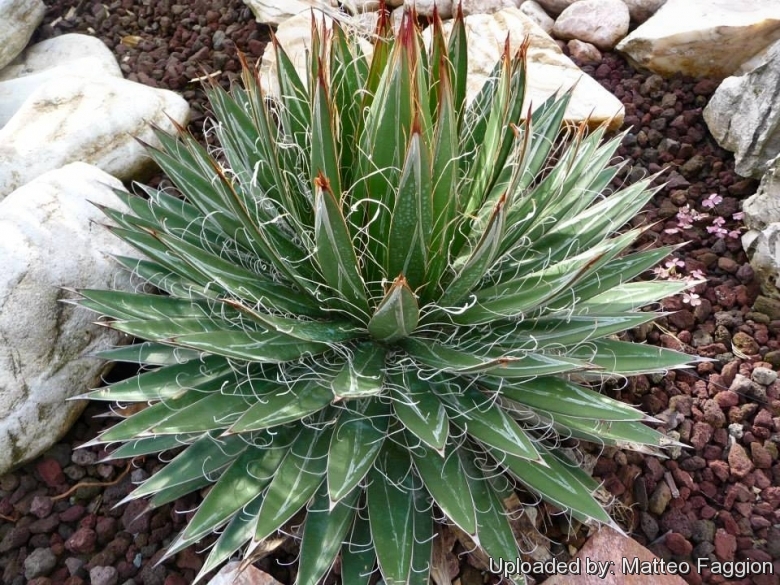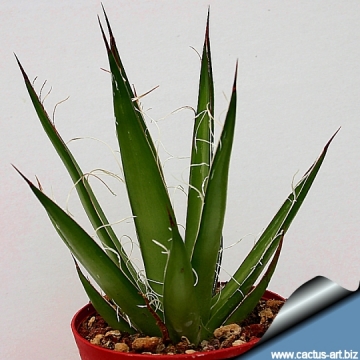Accepted Scientific Name: Agave filifera subs. schidigera (Lem.) B.Ullrich
Brit. Cact. Succ. J. 10(3): 65 (1992)

Littaea roezlii (Agave filifera subs. schidigera) Photo by: Matteo Faggion
This species is decorated with thin white curly marginal fibres spreading in all directions which sometimes are very dense.
Origin and Habitat: Mexico (Chihuahua, Durango, Sinaloa, Sonora)
Habitat: Grows on steep walled cliffs and open, exposed sites in oak woodlands from 900 to 2500 m elevation.
Synonyms:
See all synonyms of Agave filifera
Common Names include:
FINNISH (Suomi): Ripsuagaave
SPANISH (Español): Maguey
Description: Agave schidigeraSN|556]]SN|556]] (Agave filifera subs. schidigeraSN|10450]]SN|557]]) is a small or medium sized plant that forms stemless rosette to 60 to 90 cm across and 60 cm tall. It is a very symmetrical plant with straight leaves that looks a bit like Agave filiferaSN|557]]SN|10450]], perhaps having slightly wider leaves than A. filifera, but stay mostly solitary or suckers slowly but steadily. While the A. filifera branches prolifically. Some populations of Agave schidigeraSN|556]]SN|556]] have slightly curved leaves that detract from the symmetry.
Leaves: 30 to 45 cm long and 2,5 cm wide at their widest point. They are decorated with thin white curly marginal fibres spreading in all directions which sometimes are very dense. There are no marginal teeth on the leaves; however, the tip is very sharp and can inflict some damage. The leaves which vary in colour (on the same plant) from dark green to a bronzish-green colour have very ornamental white bud imprints. These imprints vary in tone and become more noticeable with age.
Flowers: The flower stalk is 3 to 3,5 m tall and is densely loaded with yellowish-green to dark purple flowers up to 5 cm long. Some send up a tall flower spike annually, while others bloom only every 30 to 40 years. Several types die after flowering, but new plants may develop from suckers at their base.
Blooming Season: Late Spring through Early Summer.
Subspecies, varieties, forms and cultivars of plants belonging to the Agave filifera group
 Agave filifera Salm-Dyck: Forms tight rosettes of narrow, hairy, stiff dull-green leaves with very sharp terminal spines.
Agave filifera Salm-Dyck: Forms tight rosettes of narrow, hairy, stiff dull-green leaves with very sharp terminal spines. Agave filifera f. cristata: This is one the very few known crested agaves, it forms a strange fan shaped, wavy rosette.
Agave filifera f. cristata: This is one the very few known crested agaves, it forms a strange fan shaped, wavy rosette. Agave filifera subs. schidigera (Lem.) B.Ullrich: Small or medium sized plant that forms stemless rosette to 60 to 90. It is decorated with thin white curly marginal fibres spreading in all directions which sometimes are very dense.
Agave filifera subs. schidigera (Lem.) B.Ullrich: Small or medium sized plant that forms stemless rosette to 60 to 90. It is decorated with thin white curly marginal fibres spreading in all directions which sometimes are very dense. Agave filifera subs. schidigera f. compacta hort.: Very compact, small, symmetrical plant, growing to 20-30 cm wide and 20-25 cm tall. Leaves decorated with thin white curly marginal fibres and with very ornamental white bud imprints.
Agave filifera subs. schidigera f. compacta hort.: Very compact, small, symmetrical plant, growing to 20-30 cm wide and 20-25 cm tall. Leaves decorated with thin white curly marginal fibres and with very ornamental white bud imprints. Agave filifera subs. schidigera cv. Shira Ito No Hoi: Rosette is composed of dark green leaves, each highlighted by a creamy-white border and curly white hairs.
Agave filifera subs. schidigera cv. Shira Ito No Hoi: Rosette is composed of dark green leaves, each highlighted by a creamy-white border and curly white hairs. Agave х leopoldii hort. ex G.Nicholson: Miniature hybrid species (A. filifera x A.filifera var. schidigiera) that has lots of fibres peeling off its short, very narrow leaves, and lots of suckers.
Agave х leopoldii hort. ex G.Nicholson: Miniature hybrid species (A. filifera x A.filifera var. schidigiera) that has lots of fibres peeling off its short, very narrow leaves, and lots of suckers. Agave х leopoldii cv. Hammer Time: The leaves are slightly elongated with a golden stripe down their edges.
Agave х leopoldii cv. Hammer Time: The leaves are slightly elongated with a golden stripe down their edges.
Bibliography: Major references and further lectures
1) Howard Scott Gentry “Agaves of Continental North America” University of Arizona Press, 01/Feb/2004
2) Urs Eggli “Illustrated Handbook of Succulent Plants: Monocotyledons” Springer, 2001
3) Hermann Jacobsen ”A Handbook of Succulent Plants: Abromeitiella to Euphorbia” Blandford Press, 1960
4) Stuart Max Walters “European Garden Flora: A Manual for the Identification of Plants Cultivated in Europe, Both Out-of-Doors and Under Glass” Cambridge University Press, 1984
5) Breitung, A. J. (1962); "Cultivated and native Agaves in the South-western United States" (Part 19; Cact. Succ. J. (USA) 34(2): 42-45.
6) Breitung, A. J(1968): "The Agaves." Cact. Succ. J. (USA) Yearbook, Abbey Garden Press, Reseda.
7) Terraciano, A. (1885): "Primo contributo ad una monografia delle Agave." Stabil. Tipogr. Barnaba Cons di Antonio, Napoli.
8) William Davidson “The illustrated directory of house plants: a practical guide to growing over 500 plants for the home” Salamander, 01/Nov/1990
9) Margaret Martin, Peter Chapman “A gardner's guide to cacti and succulents: how to grow these fascinating plants in the home and greenhouse : featuring 150 species” Salamander Books, Limited, 198
 Littaea roezlii (Agave filifera subs. schidigera) Photo by: Cactus Art
Littaea roezlii (Agave filifera subs. schidigera) Photo by: Cactus Art Young speciman from La Congoja. (Agave filifera subs. schidigera) Photo by: Valentino Vallicelli
Young speciman from La Congoja. (Agave filifera subs. schidigera) Photo by: Valentino VallicelliCultivation and Propagation: Good in containers. Agave schidigeraSN|556]]SN|556]] is a relatively easy-to-grow species tolerant of most soils. The only requirement is that it have good drainage and not be waterlogged. Plants have a moderate growth rate,
responding to some supplemental water during the growing season (spring through early fall). It is theoretically hardy to -7° C , particularly when dry. It is damaged from early morning overhead watering in the winter. The water froze resulting in pockmarks on the leaves. It grows fairly fast in summer if provided with copious water but allows to dry thoroughly before watering again. During the winter months, one should only water enough to keep the leaves from shrivelling. They do well in full sun or a lightly shaded area. Plants cultivated outdoors are drought tolerant and takes blasting heat and full sun. Benefit from fertilization in the spring and summer.
It is quite versatile. Because of its symmetrical form and relatively small size, this plant is very attractive when grown in pots. Plants can be grouped together or planted among boulders in a rock or cactus garden. They work well with perennials
Propagation: By suckers which often are found growing around the base of the plant, Remove the basal suckers (if available) in spring or summer and let the cuttings dry for a few days before inserting in compost or by seed.
Uses:A. schidigeraa is one of the species from which tequila is made. Rope, food, soap and other products are also made from the fibers and pulp.












